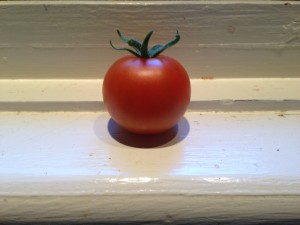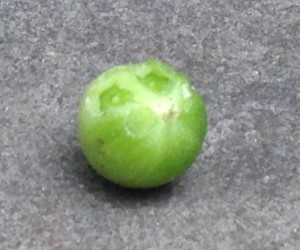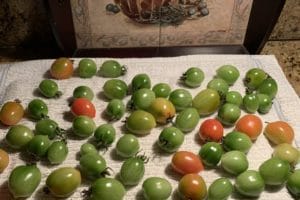Hello, Fellow Readers,
Before the first frost, I harvested the green tomatoes, leaving some for the critters to feed. A lesson I learned from Ed of Bridgewater, NJ, who gave me hand-me-down tomatoes, leading to a refresher on ripening indoors and an easy-peasy way to freeze the overabundance.
Ed tidied up his pots while we wrapped up the fall planting season, providing garden tweaks. I love tomato plants’ woodsy, earthy smell and adore the more compact varieties planted amongst perennials such as echinacea and salvia. As Ed was cutting them down, the smell heightened.
The Gift of Hand-me-Down Tomatoes
The cuttings went to the compost pile, and he gifted me the green tomatoes, almost heart-shaped, with a teardrop point at the end.
“What kind of tomatoes are they?”
“I’m not sure. A friend brought back seeds from Sicily, and I’ve harvested seeds from the tomatoes for years and planted them the next year. The funny thing is, the fruit has gotten a bit bigger each year.”
Some are half-dollar sized, and others are still the original quarter-sized, about the size of cherry tomatoes.
During the summer overabundance, Ed tosses them into the freezer in bags, “skin and all, and use them in whatever I make.” Nifty idea!

Happy First Tomato
I told the story of my previous cherry tomato attempts in pots hindered by the resident chipmunks who took one bite out of each just before they ripened, leaving them littering the ground. I’d have been less upset if they ate the whole darn thing; The slaughter would be somewhat hidden, and at least the food isn’t wasted.

Cherry Tomato Carnage
Ed’s generous bounty had a few chomp marks that healed over. How polite his chipmunks are to at least leave them on the vine where they could heal and grow.
Ripening Tomatoes Indoors
Tomatoes are one of the only “vegetables” (because they are a fruit) you can harvest before they fully ripen. Picking them early can prevent splitting or bruising and allows you to control the ripening process. They must be full size, known as the mature green stage. It’s when they turn lighter and have a gel-like substance inside. At this stage, two growth hormones change and cause the production of ethylene gas, which ages the cells, resulting in ripening.
Keep them out of direct sunlight, and they’ll reach peak ripeness in seven to ten days. Or, if you wish them to ripen faster, put them in a brown paper bag, which will contain the ethylene gas.

Ed’s Hand-me-Down Tomatoes
The “Skin and All” Technique
Store tomatoes at fifty-five to seventy degrees, cooler if you wish to slow the ripening, and regularly check for ripeness. Then enjoy the bounty before the assailants or the first heavy frost snags them, and at the same time, avoid skin cracks, green shoulders, and stretch marks (lucky tomatoes).
Those that ripen too fast to use will go in the freezer using Ed’s “skin and all” technique, as storing tomatoes in the frig makes them mealy and ruins the flavor, much like off-season tomatoes at the grocer.
Those that won’t ripen can become fried green tomatoes. But five hundred calories a serving (one large cornmeal, breadcrumb, and flour-encased fried tomato) may be a deterrent versus fifty calories for a fresh one. Instead, I may gift them to our resident chipmunks —far away from the garden :^).
It’s year three of my veggie garden, and volunteer cherry tomatoes have reseeded themselves. Ones that can seed in the ground in our zone (5b) and bear fruit, so you don’t need to start them indoors. I wish I could tell you the variety, but it’s long forgotten. Just like the tomato carnage I used to endure. Well, maybe not (smile).
Garden Dilemmas? AskMaryStone@gmail.com (and your favorite Podcast App.)
Related Stories You’ll Enjoy:
A terrific source for Organic Vegetable Seeds: Johnny’s Selected Seeds
There’s more to the story in The Garden Dilemmas Podcast
***
When I arrived, Dolce, Ed’s kindhearted lab, welcomed me.






Why are the chipmunks eating one bite of the tomatoes? Cheeky!
Likely because they are yummy and they can. Smile. Thanks for reading the story, Mary
Thank you! You too!